The image of a distant object forms either in front of or behind the retina
The principle of ametropia
The eye and vision
80 % of all the information our brains receive is via the eyes.
Vision: How does sight work?
The optical system that enables visual perception is very complex
The eye intercepts light.
An image of the external world is created on the retina.
The nervous system transmits this image to the brain.
The brain interprets the information received to form an image.
The crystalline lens: the organ that helps the eye adjust
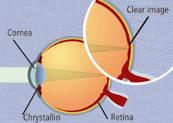
The crystalline lens plays an essential role in vision. This lens contracts and expands to focus rays of light on the retina.
Like an autofocus camera lens, it helps to adjust images in accordance with the distance of the external object, a function that is called accommodation.
"Normal" eyesight
When the eye presents no visual disorder, images of near or far objects are formed on the retina through accommodation. The crystalline lens bulges in or out according to its distance from the object in order to create a focused image.
Vision is blurred or deformed when the image of the object does not form on the retina. This type of visual disorder is called ametropia. There are three kinds of ametropia: myopia, hyperopia and astigmatism.
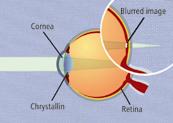
Distant objects are fairly clear but images close up are blurred: correction is carried out using positive strength convex lenses.
Hypermetropia is a visual fault due to an insufficiently strong eye (�too short�). The image is formed behind the retina, which explains why a hypermetropic person sees better at long- distance than at short-distance.
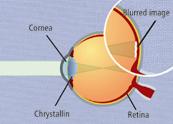
Distant objects are blurred while those which are closer are clear; correction is carried out using negative strength concave lenses.
Myopia is a visual fault due to the eye being too long: the distance between the cornea and the retina is too large. The image is formed in front of the retina and the myopic person sees poorly at long-distance but well at short-distance.
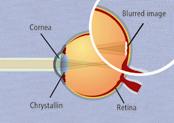
This ametropia is the most common, and due to an irregularity of the curve of the cornea; vision of objects is thus deformed and imprecise, both at short and long-distance. The eye needs to be corrected in a different way, in two perpendicular directions; the correction is carried out through toric lenses, which can be negative or positive.
Astigmatism is a visual fault generally due to the curve of the cornea, which is slightly oval instead of being round.
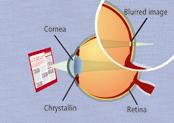
Presbyopia is not a real ametropia. It is a natural development of sight, which affects everyone from the age of 40 onwards. For the 20 million people in France who already have presbyopia, short-sightedness results from a loss of suppleness in the chrystallin which curves insufficiently and is therefore unable to adjust easily. The result is a gradually increasing difficulty in near-distance vision.
Presbyopia only occurs in CV. The ability to adapt has become insufficient, making it difficult to focus on close objects (when reading for example).